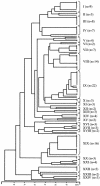Penicillin susceptibility and epidemiological typing of invasive pneumococcal isolates in the Republic of Ireland
- PMID: 12904369
- PMCID: PMC179845
- DOI: 10.1128/JCM.41.8.3641-3648.2003
Penicillin susceptibility and epidemiological typing of invasive pneumococcal isolates in the Republic of Ireland
Abstract
A national study was undertaken to investigate the incidence of invasive pneumococcal disease in the Republic of Ireland and to examine the associated isolates. In 1999, 144 S. pneumoniae isolates, all recovered from cases of invasive disease, were received from 12 microbiology laboratories. The incidence of invasive pneumococcal disease was estimated to be 6.6/100000 population. All isolates were analyzed for serotype, penicillin susceptibility, chromosomal relatedness (by using pulsed-field gel electrophoresis [PFGE]), and penicillin-binding protein (pbp) fingerprinting. Several findings of note were observed regarding the pneumococcal population in Ireland. First, isolates of 25 different serotypes were represented, with serotypes 14, 9V, 8, 5, 4, and 3 being the most common. This finding, together with the pbp fingerprinting and PFGE typing results, indicated the clonal spread of strains of these serotypes in Ireland. Second, 27 (18.7%) isolates had reduced susceptibility to penicillin, and 74% of these were serotype 9V. Of these, 80% appeared to belong to the same clone. This could suggest the spread of the international Spanish/French 9V penicillin-resistant clone into Ireland. Third, nine different pbp genotypes were identified, four of which were new. Two pbp genotypes accounted for the majority of isolates dividing them according to their penicillin susceptibility status but irrespective of serotype and PFGE type. This is strong evidence for the occurrence of horizontal transfer of pbp genes between strains, observed with both penicillin-susceptible and penicillin-nonsusceptible isolates. Fourth, there was evidence of serotype transformation since isolates, indistinguishable by pbp fingerprinting and PFGE typing, expressed different capsular types.
Figures


Similar articles
-
Molecular epidemiology of penicillin-resistant Streptococcus pneumoniae isolates recovered in Italy from 1993 to 1996.J Clin Microbiol. 1998 Oct;36(10):2944-9. doi: 10.1128/JCM.36.10.2944-2949.1998. J Clin Microbiol. 1998. PMID: 9738048 Free PMC article.
-
Presence of international multiresistant clones of Streptococcus pneumoniae in Colombia.Microb Drug Resist. 2001 Summer;7(2):153-64. doi: 10.1089/10766290152045020. Microb Drug Resist. 2001. PMID: 11442341
-
Emergence of penicillin-nonsusceptible Streptococcus pneumoniae invasive clones in Canada.J Clin Microbiol. 2002 Jan;40(1):68-74. doi: 10.1128/JCM.40.1.68-74.2002. J Clin Microbiol. 2002. PMID: 11773094 Free PMC article.
-
Epidemiological and molecular characterization of invasive Streptococcus pneumoniae isolated following introduction of 7-valent conjugate vaccine in Kinki region, Japan, 2008-2013.J Infect Chemother. 2020 May;26(5):451-458. doi: 10.1016/j.jiac.2019.11.010. Epub 2019 Dec 20. J Infect Chemother. 2020. PMID: 31870586
-
Genetic analysis of serotype 23F Streptococcus pneumoniae isolates from several countries by penicillin-binding protein gene fingerprinting and pulsed-field gel electrophoresis.Chemotherapy. 1999 May-Jun;45(3):158-65. doi: 10.1159/000007178. Chemotherapy. 1999. PMID: 10224337
Cited by
-
Multiplex PCR for identification of seven Streptococcus pneumoniae serotypes targeted by a 7-valent conjugate vaccine.J Clin Microbiol. 2005 Jul;43(7):3487-90. doi: 10.1128/JCM.43.7.3487-3490.2005. J Clin Microbiol. 2005. PMID: 16000486 Free PMC article.
-
Molecular analysis of pbp2b in Streptococcus pneumonia isolated from clinical and normal flora samples.Curr Microbiol. 2015 Feb;70(2):206-11. doi: 10.1007/s00284-014-0704-7. Epub 2014 Oct 2. Curr Microbiol. 2015. PMID: 25274412
-
Impact of the European Antimicrobial Resistance Surveillance System on the development of a national programme to monitor resistance in Staphylococcus aureus and Streptococcus pneumoniae in Ireland, 1999-2003.Eur J Clin Microbiol Infect Dis. 2005 Jul;24(7):480-3. doi: 10.1007/s10096-005-1357-z. Eur J Clin Microbiol Infect Dis. 2005. PMID: 15977004
-
Molecular characterization of non-penicillin-susceptible Streptococcus pneumoniae in Norway.J Clin Microbiol. 2006 Sep;44(9):3225-30. doi: 10.1128/JCM.00524-06. J Clin Microbiol. 2006. PMID: 16954252 Free PMC article.
-
Analysis of amino acid motif of penicillin-binding proteins 1a, 2b, and 2x in invasive Streptococcus pneumoniae nonsusceptible to penicillin isolated from pediatric patients in Casablanca, Morocco.BMC Res Notes. 2018 Aug 31;11(1):632. doi: 10.1186/s13104-018-3719-5. BMC Res Notes. 2018. PMID: 30170603 Free PMC article.
References
-
- Alpern, E., E. Alessandrini, K. McGowan, L. Bell, and K. Shaw. 2001. Serotype prevalence of occult pneumococcal bacteremia. Pediatrics 108:E23. - PubMed
-
- Aszkenasy, O., R. George, and N. Begg. 1995. Pneumococcal bacteraemia and meningitis in England and Wales 1982 to 1992. Commun. Dis. Rep. CDR Rev. 5:R45-R50. - PubMed
-
- Barcus, V., K. Ghanekar, M. Yeo, T. Coffey, and C. Dowson. 1995. Genetics of high-level penicillin resistance in clinical isolates of Streptococcus pneumoniae. FEMS Microbiol. Lett. 126:299-304. - PubMed
-
- Cartwright, K. 2002. Pneumococcal disease in western Europe: burden of disease, antibiotic resistance and management. Eur. J. Pediatr. 161:188-195. - PubMed
Publication types
MeSH terms
Substances
LinkOut - more resources
Full Text Sources
Medical
Research Materials
Miscellaneous

